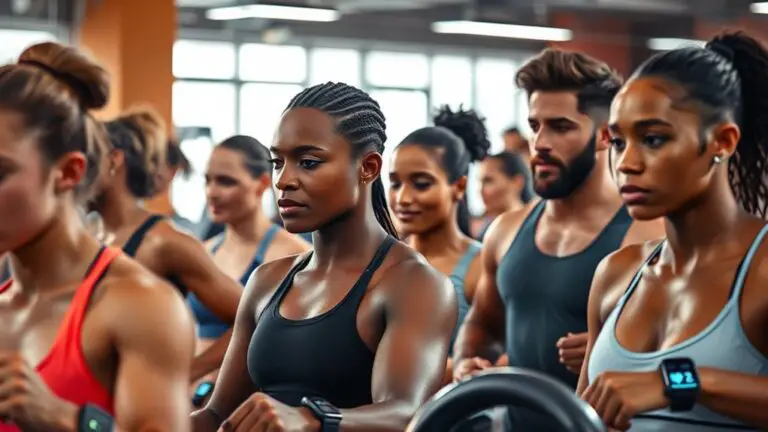The Role of Visualization in Gym Performance

Visualization plays an essential role in gym performance by helping you mentally rehearse workouts and techniques. It boosts your confidence and reduces anxiety, creating a safer workout environment. By picturing yourself succeeding, you enhance muscle memory and coordination without physical strain. Regular practice reinforces neural pathways, making execution smoother. Plus, it allows you to overcome mental barriers. Discovering techniques to incorporate visualization can elevate your training experience even further.
Understanding Visualization in Sports

Visualization in sports, especially in gym performance, is a powerful technique that can enhance your training and competition outcomes. It involves mental rehearsal, where you picture yourself successfully completing exercises or routines. This process helps build confidence and reduces anxiety, creating a safer environment for your workouts.
Imagery consistency is key; the more vividly and regularly you visualize your movements, the better your brain adapts. By consistently imagining the correct form and technique, you reinforce neural pathways, making your actual performance smoother and more effective.
Incorporating visualization into your routine can be as simple as taking a few minutes before each workout to mentally walk through your exercises. This practice not only prepares you physically but also mentally, ensuring you’re focused and ready to achieve your fitness goals safely. Remember, visualization is a skill that improves with practice, so be patient and committed to enhancing your gym experience.
The Science Behind Visualization
While many athletes swear by visualization’s effectiveness, the science behind it reveals why this technique works so well. Neuroscience insights show that when you visualize an action, your brain activates similar neural pathways as if you were actually performing it. This means your cognitive processes can enhance muscle memory and coordination, even when you’re not physically training.
Here’s a quick look at key components of visualization:
| Component | Description | Benefits |
|---|---|---|
| Mental Imagery | Creating vivid images in your mind | Enhances focus |
| Neuroplasticity | Brain’s ability to change structure | Improves skill retention |
| Emotional Regulation | Managing stress and anxiety | Boosts confidence |
| Goal Setting | Defining clear objectives | Increases motivation |
| Consistency | Regular practice of visualization | Reinforces mental training |
Benefits of Visualization for Athletes

Athletes who incorporate visualization into their training often experience a range of benefits that enhance their performance. One of the key advantages is mental rehearsal, which allows you to mentally practice techniques and strategies without the physical strain. This can help reduce anxiety, making you feel more prepared and confident during competitions.
Moreover, visualization can improve focus, enabling you to block out distractions and maintain a clear mindset while you train or compete. By picturing successful outcomes, you’re also training your brain to respond positively in high-pressure situations.
Additionally, using visualization can enhance your motivation, reinforcing your goals and commitment to your training routine. This mental training complements physical workouts, ensuring you’re not only fit but also mentally sharp and ready to perform at your best. Overall, integrating visualization into your regimen can lead to significant performance enhancement while prioritizing your safety and well-being.
Techniques for Effective Visualization
To effectively harness the power of visualization, it’s essential to use specific techniques that resonate with you. Incorporating mental rehearsal and imagery practice can elevate your gym performance while ensuring you feel safe and confident.
Harnessing visualization techniques can significantly enhance your gym performance, boosting confidence and safety during workouts.
Here are three techniques to reflect upon:
- Detailed Imagery: Picture every aspect of your workout—from your grip on the weights to the feeling of your muscles contracting. This clarity can enhance your focus.
- Positive Affirmations: Pair your visualization with affirmations. Repeat phrases like “I’m strong” or “I can do this” to build mental resilience and foster a positive mindset.
- Emotion Connection: Visualize not just the actions but the emotions tied to success. Feel the excitement of hitting a new personal best, allowing that energy to motivate you during workouts.
Creating a Visualization Routine

Incorporating the techniques of detailed imagery, positive affirmations, and emotional connections into a visualization practice is just the beginning. To create a strong visualization routine, start by setting aside a quiet space where you can focus without distractions. This safe environment will help you engage fully in your visualization exercises.
Begin with deep breathing to calm your mind and body, then visualize your workout or performance in vivid detail. Picture each movement clearly, imagining the sensations and emotions you’ll experience. This mental rehearsal helps reinforce your confidence and prepares you for real-life scenarios.
To enhance the routine, incorporate positive affirmations that resonate with you, repeating them as you visualize. Consistency is key, so commit to practicing daily, gradually increasing the duration as you become more comfortable. With dedication, your visualization routine will empower you, boosting not only your gym performance but also your overall confidence.
Visualization for Specific Gym Activities
While many people know the benefits of visualization in general, applying it to specific gym activities can greatly enhance your performance. When you focus on your individual exercises, you can create a safer and more effective workout. Here are three ways to use visualization effectively:
- Weightlifting Visualization: Before lifting, imagine yourself completing each rep with perfect form. Picture the weight moving smoothly and your muscles working efficiently.
- Cardio Visualization: Visualize yourself finishing strong during your cardio session. See the finish line and the sense of accomplishment that comes with it, boosting your motivation and endurance.
- Mind-Body Connection: Envision the connection between your mind and body. This helps you stay calm, focused, and in control, reducing the risk of injury. Additionally, using visualization techniques can enhance your jump rope exercise benefits, as the mental imagery helps improve coordination and stamina.
Overcoming Mental Barriers With Visualization
When you face mental barriers in the gym, visualization can be your powerful ally. By using mental imagery techniques, you can build confidence and tackle fears that hold you back. Let’s explore how harnessing this skill can transform your performance and mindset.
Mental Imagery Techniques
As you endeavor to reach your fitness goals, mental imagery techniques can play an essential role in overcoming mental barriers. By using mental rehearsal, you can visualize your workouts, enabling you to prepare mentally for challenges ahead. Imagery scripts can guide you through vivid scenarios, making you feel the emotions that come with success.
Here are three techniques to contemplate:
- Visualize Success: Picture yourself completing a challenging workout or lifting that weight you’ve been struggling with.
- Create a Safe Space: Imagine a calm environment where you feel confident and protected while working out.
- Practice Daily: Set aside time each day to engage in mental rehearsal, reinforcing your commitment and resilience.
Embrace these techniques to enhance your performance safely!
Building Confidence Through Visualization
Visualization isn’t just about imagining success; it’s a powerful tool for building confidence and overcoming mental barriers in your fitness journey. By practicing mental rehearsal, you can visualize yourself performing exercises safely and effectively, which helps reinforce your ability to succeed. This confidence-boosting technique allows you to picture each movement, from lifting weights to completing a run, in a relaxed and focused state. As you repeatedly visualize these actions, your mind becomes more accustomed to them, reducing anxiety and self-doubt. This process not only enhances your performance but also cultivates a strong mindset. So, take a few moments before your workouts to engage in visualization, and watch your confidence soar as you tackle each gym session with renewed assurance.
Overcoming Fear and Doubt
Building confidence through visualization naturally leads to addressing the fears and doubts that often hold you back in the gym. By practicing fear management and doubt reduction, you can create a safer, more empowering environment for yourself. Here are three ways visualization can help:
- Visualize Success: Picture yourself completing that challenging lift or workout, reinforcing the belief that you can achieve it.
- Identify Triggers: Recognize what specifically triggers your fears and visualize overcoming those situations calmly and effectively.
- Emotional Anchoring: Connect positive feelings to your visualization, helping to replace anxiety with confidence and determination.
As you incorporate these techniques, you’ll find that your mental barriers start to crumble, allowing you to focus on progress and personal growth.
Success Stories: Athletes Who Use Visualization
Many elite athletes have harnessed the power of visualization to enhance their performance and achieve remarkable success. You might be surprised to learn that many of these athletes credit visualization workshops for changing their mindset and boosting their confidence. For instance, a well-known sprinter shares how visualizing each race helped him overcome anxiety, allowing him to focus on his technique. Another athlete, a professional gymnast, believes that picturing her routines in detail not only improves her skills but also keeps her safe from injury. These athlete testimonials highlight the effectiveness of visualization in preparing mentally for competition. By incorporating these techniques into your training, you too can experience the benefits. Whether it’s before a workout or during a competition, envisioning your success can create a powerful mental framework that fosters safety and achievement. Embrace visualization and see how it can transform your performance!
Combining Visualization With Physical Training
While you might think physical training alone is enough to improve your performance, combining it with visualization can take your results to the next level. By incorporating mental rehearsal into your routine, you can enhance your focus and boost your confidence safely. Here are three ways visualization can help you in the gym:
- Increased Motivation: Visualizing your goals sparks excitement and keeps you committed to your training plan.
- Improved Technique: Mentally rehearsing movements can refine your form, reducing the risk of injury while maximizing effectiveness.
- Enhanced Recovery: Imagining the successful completion of workouts can promote mental rest and emotional well-being, allowing your body to recover efficiently.
Frequently Asked Questions
Can Visualization Help With Injury Recovery in Athletes?
Isn’t it fascinating how the mind can influence the body’s healing? Yes, visualization can definitely aid in injury recovery for athletes. By employing mental imagery alongside rehabilitation techniques, you’re not just resting; you’re actively engaging your mind in the healing process. This approach can enhance motivation, reduce anxiety, and even improve strength. So, as you recover, remember that your thoughts can be powerful allies in regaining your athletic prowess while prioritizing safety.
How Long Should I Spend on Visualization Each Day?
When it comes to daily duration for visualization, aim for about 10 to 20 minutes each day. This time frame allows you to focus without feeling overwhelmed. Ideal timing can vary; consider doing it in the morning or before workouts when your mind’s fresh. Consistency is key, so find a routine that feels natural for you. Just remember, it’s important to incorporate this practice safely, ensuring it complements your overall training and recovery.
Does Visualization Work for Beginners or Only Advanced Athletes?
Visualization’s effective for both beginners and advanced athletes. As a beginner, you can benefit from mental imagery to build confidence and establish a positive mindset. It doesn’t require advanced techniques; simple visualization exercises can help you imagine successful workouts and techniques. This practice can enhance your focus and safety, making your training more effective. So, don’t hesitate to incorporate visualization into your routine, regardless of your experience level!
Can Visualization Replace Physical Training Entirely?
Think of visualization as a compass guiding you through uncharted waters. While mental rehearsal can enhance your performance and sharpen skills, it can’t replace the physical training needed to build strength and endurance. Just as a compass can’t sail a ship, visualization alone won’t prepare your body for the demands of exercise. It’s a powerful tool, but for safety and success, combine it with regular physical training to achieve your best results.
What if I Struggle to Visualize Effectively?
If you struggle to visualize effectively, don’t worry; it’s a common challenge. Start by practicing mental clarity through relaxation techniques, like deep breathing or meditation. Then, try different visualization techniques, such as imagining a successful outcome or breaking down the process into smaller steps. Remember, it’s about finding what works best for you. With patience and practice, your visualization skills can improve, enhancing your overall performance while ensuring you stay safe.





